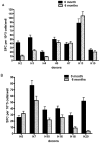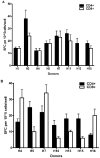Healthy human T-Cell Responses to Aspergillus fumigatus antigens
- PMID: 20174463
- PMCID: PMC2822840
- DOI: 10.1371/journal.pone.0009036
Healthy human T-Cell Responses to Aspergillus fumigatus antigens
Abstract
Background: Aspergillus fumigatus is associated with both invasive and allergic pulmonary diseases, in different hosts. The organism is inhaled as a spore, which, if not cleared from the airway, germinates into hyphal morphotypes that are responsible for tissue invasion and resultant inflammation. Hyphae secrete multiple products that function as antigens, evoking both a protective (T(H)1-T(H)17) and destructive allergic (T(H)2) immunity. How Aspergillus allergens (Asp f proteins) participate in the development of allergic sensitization is unknown.
Methodology/principal findings: To determine whether Asp f proteins are strictly associated with T(H)2 responses, or represent soluble hyphal products recognized by healthy hosts, human T cell responses to crude and recombinant products were characterized by ELISPOT. While responses (number of spots producing IFN-gamma, IL-4 or IL-17) to crude hyphal antigen preparations were weak, responses to recombinant Asp f proteins were higher. Recombinant allergens stimulated cells to produce IFN-gamma more so than IL-4 or IL-17. Volunteers exhibited a diverse CD4+ and CD8+ T cell antigen recognition profile, with prominent CD4 T(H)1-responses to Asp f3 (a putative peroxismal membrane protein), Asp f9/16 (cell wall glucanase), Asp f11 (cyclophilin type peptidyl-prolyl isomerase) and Asp f22 (enolase). Strong IFN-gamma responses were reproduced in most subjects tested over 6 month intervals.
Conclusions: Products secreted after conidial germination into hyphae are differentially recognized by protective T cells in healthy, non-atopic individuals. Defining the specificity of the human T cell repertoire, and identifying factors that govern early responses may allow for development of novel diagnostics and therapeutics for both invasive and allergic Aspergillus diseases.
Conflict of interest statement
Figures





References
-
- Gersuk GM, Underhill DM, Zhu L, Marr KA. Dectin-1 and TLRs permit macrophages to distinguish between different Aspergillus fumigatus cellular states. J Immunol. 2006;176:3717–3724. - PubMed
-
- Aimanianda V, Bayry J, Bozza S, Kniemeyer O, Perruccio K, et al. Surface hydrophobin prevents immune recognition of airborne fungal spores. Nature. 2009;460:1117–1121. - PubMed
-
- LeibundGut-Landmann S, Gross O, Robinson MJ, Osorio F, Slack EC, et al. Syk- and CARD9-dependent coupling of innate immunity to the induction of T helper cells that produce interleukin 17. Nat Immunol. 2007;8:630–638. - PubMed
Publication types
MeSH terms
Substances
Grants and funding
LinkOut - more resources
Full Text Sources
Other Literature Sources
Research Materials
Miscellaneous

